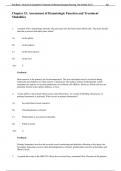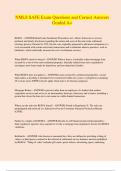Test Bank - Brunner & Suddarth's Textbook of Medical-Surgical Nursing 14e (Hinkle 2017) 621
Chapter 32: Assessment of Hematologic Function and Treatment
Modalities
1. A patient with a hematologic disorder asks the nurse how the body forms blood cells. The nurse should
describe a process that takes place where?
A) In the spleen
B) In the kidneys
C) In the bone marrow
D) In the liver
Ans: C
Feedback:
Bone marrow is the primary site for hematopoiesis. The liver and spleen may be involved during
embryonic development or when marrow is destroyed. The kidneys release erythropoietin, which
stimulates the marrow to increase production of red blood cells (RBCs). However, blood cells are not
primarily formed in the spleen, kidneys, or liver.
2. A man suffers a leg wound which causes minor blood loss. As a result of bleeding, the process of
primary hemostasis is activated. What occurs in primary hemostasis?
A) Severed blood vessels constrict.
B) Thromboplastin is released.
C) Prothrombin is converted to thrombin.
D) Fibrin is lysed.
Ans: A
Feedback:
Primary hemostasis involves the severed vessel constricting and platelets collecting at the injury site.
Secondary hemostasis occurs when thromboplastin is released, prothrombin converts to thrombin, and
fibrin is lysed.
3. A patient has come to the OB/GYN clinic due to recent heavy menstrual flow. Because of the patients
,Test Bank - Brunner & Suddarth's Textbook of Medical-Surgical Nursing 14e (Hinkle 2017) 622
consequent increase in RBC production, the nurse knows that the patient may need to increase her daily
intake of what substance?
A) Vitamin E
B) Vitamin D
C) Iron
D) Magnesium
Ans: C
Feedback:
To replace blood loss, the rate of red cell production increases. Iron is incorporated into hemoglobin.
Vitamins E and D and magnesium do not need to be increased when RBC production is increased.
4. The nurse is planning the care of a patient with a nutritional deficit and a diagnosis of megaloblastic
anemia. The nurse should recognize that this patients health problem is due to what?
A) Production of inadequate quantities of RBCs
B) Premature release of immature RBCs
C) Injury to the RBCs in circulation
D) Abnormalities in the structure and function RBCs
Ans: D
Feedback:
Vitamin B12 and folic acid deficiencies are characterized by the production of abnormally large
erythrocytes called megaloblasts. Because these cells are abnormal, many are sequestered (trapped)
while still in the bone marrow, and their rate of release is decreased. Some of these cells actually die in
the marrow before they can be released into the circulation. This results in megaloblastic anemia. This
pathologic process does not involve inadequate production, premature release, or injury to existing
RBCs.
5. A nurse is caring for a patient who undergoing preliminary testing for a hematologic disorder. What sign
or symptom most likely suggests a potential hematologic disorder?
A) Sudden change in level of consciousness (LOC)
,Test Bank - Brunner & Suddarth's Textbook of Medical-Surgical Nursing 14e (Hinkle 2017) 623
B) Recurrent infections
C) Anaphylaxis
D) Severe fatigue
Ans: D
Feedback:
The most common indicator of hematologic disease is extreme fatigue. This is more common than
changes in LOC, infections, or analphylaxis.
6. The nurse caring for a patient receiving a transfusion notes that 15 minutes after the infusion of packed
red blood cells (PRBCs) has begun, the patient is having difficulty breathing and complains of severe
chest tightness. What is the most appropriate initial action for the nurse to take?
A) Notify the patients physician.
B) Stop the transfusion immediately.
C) Remove the patients IV access.
D) Assess the patients chest sounds and vital signs.
Ans: B
Feedback:
Vascular collapse, bronchospasm, laryngeal edema, shock, fever, chills, and jugular vein distension are
severe reactions. The nurse should discontinue the transfusion immediately, monitor the patients vital
signs, and notify the physician. The blood container and tubing should be sent to the blood bank. A
blood and urine specimen may be needed if a transfusion reaction or a bacterial infection is suspected.
The patients IV access should not be removed.
7. The nurse is describing the role of plasminogen in the clotting cascade. Where in the body is
plasminogen present?
A) Myocardial muscle tissue
B) All body fluids
C) Cerebral tissue
D) Venous and arterial vessel walls
, Test Bank - Brunner & Suddarth's Textbook of Medical-Surgical Nursing 14e (Hinkle 2017) 624
Ans: B
Feedback:
Plasminogen, which is present in all body fluids, circulates with fibrinogen. Plasminogen is found in
body fluids, not tissue.
8. The nurse is caring for a patient who has developed scar tissue in many of the areas that normally
produce blood cells. What organs can become active in blood cell production by the process of
extramedullary hematopoiesis?
A) Spleen and kidneys
B) Kidneys and pancreas
C) Pancreas and liver
D) Liver and spleen
Ans: D
Feedback:
In adults with disease that causes marrow destruction, fibrosis, or scarring, the liver and spleen can also
resume production of blood cells by a process known as extramedullary hematopoiesis. The kidneys and
pancreas do not produce blood cells for the body.
9. Through the process of hematopoiesis, stem cells differentiate into either myeloid or lymphoid stem
cells. Into what do myeloid stem cells further differentiate? Select all that apply.
A) Leukocytes
B) Natural killer cells
C) Cytokines
D) Platelets
E) Erythrocytes
Ans: A, D, E
Feedback:





